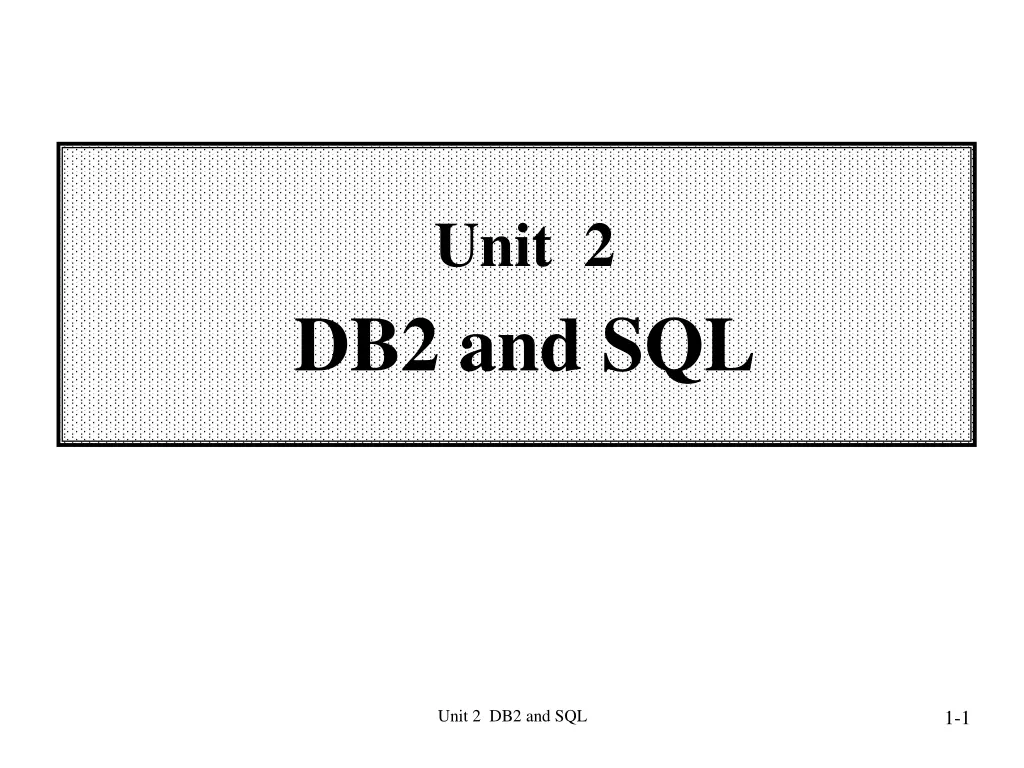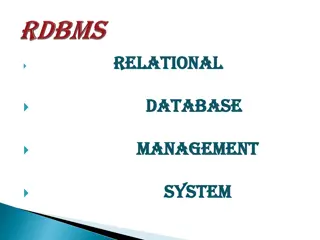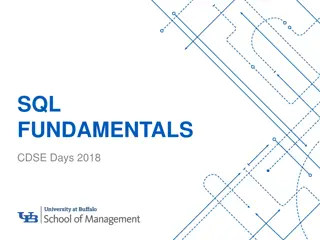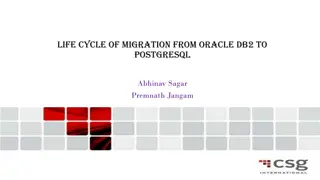
Overview of Unit 2 - DB2 and SQL
Explore the fundamentals of DB2 and SQL in Unit 2, covering topics such as data definition, manipulation, the system catalog, embedded SQL, and the background of relational databases. Learn about the structure of relational databases, normalization, and major system components like DB2 and SQL.
Download Presentation

Please find below an Image/Link to download the presentation.
The content on the website is provided AS IS for your information and personal use only. It may not be sold, licensed, or shared on other websites without obtaining consent from the author. If you encounter any issues during the download, it is possible that the publisher has removed the file from their server.
You are allowed to download the files provided on this website for personal or commercial use, subject to the condition that they are used lawfully. All files are the property of their respective owners.
The content on the website is provided AS IS for your information and personal use only. It may not be sold, licensed, or shared on other websites without obtaining consent from the author.
E N D
Presentation Transcript
Unit 2 DB2 and SQL Unit 2 DB2 and SQL 1-1
Outline of Unit 2 2.1 Overview DB2 2.2 Data Definition 2.3 Data Manipulation 2.4 The System Catalog 2.5 Embedded SQL 2.6 Unit 2 DB2 and SQL 2-2 Wei-Pang Yang, Information Management, NDHU
2.1 Overview DB2 Unit 2 DB2 and SQL 1-3
Background Relational Model: proposed by Codd, 1970 Ref: A Relational Model of Data for Large Shared Data Banks, CACM, 13(6):377-387, June 1970. System R INGRES Developer IBM San Jose Res. Lab 1974 - 1979 UC Berkeley late 1970 - early 1980 Machine O. S. Query Language IBM System 370 DEC PDP VM / CMS UNIX SQL QUEL Language Embedded COBOL or PL/1 COBOL, PASCAL, C FORTRAN, BASIC Commercial Product DB2, SQL / DS Commercial INGRES Distributed OB R* Distributed INGRES OO Extension Starburst POSTGRES Unit 2 DB2 and SQL 2-4 Wei-Pang Yang, Information Management, NDHU
Relational Databases Definition: A Relational Database is a database that is perceived by its users as a collection of tables (and nothing but tables). <e.g.> Supplier-and-Parts Database S SP (Hierarchical Model) IMS S# SNAME STATUS CITY S1 Smith 20 London S2 Jones 10 Paris S3 Blake 30 Paris S4 Clark 20 London S5 Adams 30 Athens S# P# QTY S1 P1 300 S1 P2 200 S1 P3 400 S1 P4 200 S1 P5 100 S1 P6 100 S2 P1 300 S2 P2 400 S3 P2 200 S4 P2 200 S4 P4 300 S4 P5 400 vs. P P# PNAME COLOR WEIGHT CITY P1 Nut Red 12 London P2 Bolt Green 17 Paris P3 Screw Blue 17 Rome P4 Screw Red 14 London P5 Cam Blue 12 Paris P6 Cog Red 19 London Unit 2 DB2 and SQL 2-5 Wei-Pang Yang, Information Management, NDHU
Relational Databases (cont.) SP S# P# QTY S1 P1 300 S1 P2 200 S1 P3 400 S1 P4 200 S1 P5 100 S1 P6 100 S2 P1 300 S2 P2 400 S3 P2 200 S4 P2 200 S4 P4 300 S4 P5 400 P P# PNAME COLOR WEIGHT CITY P1 Nut Red 12 London P2 Bolt Green 17 Paris P3 Screw Blue 17 Rome P4 Screw Red 14 London P5 Cam Blue 12 Paris P6 Cog Red 19 London S S# SNAME STATUS CITY S1 Smith 20 London S2 Jones 10 Paris S3 Blake 30 Paris S4 Clark 20 London S5 Adams 30 Athens S, P, SP: 3 relations (tables) A row in a relation is called a tuple (record) S, P: entities; SP: relationship primary key: S# in S, P# in P, (S#, P#) in SP atomic: not a set of values, instead of repeating group < e.g. > S# P# --------------------------------------------------- S1 { P1, P2, P3, P4, P5, P6 } S2 { P1, P2 } . .. . . . atomic Normalization Unit 2 DB2 and SQL 2-6 Wei-Pang Yang, Information Management, NDHU
Major System Components: DB2 PL/I + SQL:(P.2- 46) EXEC SQL CREATE TABLE S ( S# CHAR(5), ......) EXEC SQL SELECT SNAME INTO :SNAME FROM S IF SQLCODE < 0 THEN ....... 1. Pre-compiled 2. Bind 3. Runtime Supervisor 4. Data Manager 5. Buffer Manager Source Module CALL CREATE( ......) CALL SELECT( ......) IF SQLCODE < 0 THEN ....... Modified Source Module Pre-compiler DBRM request module parse-tree version of SQL PL/I source PL/I-Compiler Bind a DB Compiler optimized machine codes of SQL statements Object Module Application Plan in system Catalog Linkage Editor (Load Module) 2 1st time 3 (Application Plan) 3' 1 Load Module Runtime Supervisor 4 Data Manager Buffer Manager DB (Other) Unit 2 DB2 and SQL 2-7 Wei-Pang Yang, Information Management, NDHU
Major System Components: Execution time Execution time PL / 1 LOAD MODULE P If - - CALL - Catalog or Dictionary "data about data" Runtime Supervisor (Ref. p. 2-34) Application Plan ( for P ) Stored Data Manager Database "data" Buffer Manager Unit 2 DB2 and SQL 2-8 Wei-Pang Yang, Information Management, NDHU
Major System Components: Optimizer - Plan 1 (without index): SCAN S if S # = 'S4 then extract name field go to SCAN S ... DBRM Application Plan 1 - Plan 2 (with sorted index): Binary Search X if X.key = 'S4 then .......... SELECT SNAME INTO SNAME FROM S WHERE S# = 'S4' BIND OPTIMIZER Be chosen by optimizer (Ref. p. 2-34) Application Plan 2 - Considerations : 1. Which table ? 2. How big ? 3. What index exist ? X: S#_index s1 s2... S# ... Unit 2 DB2 and SQL 2-9 Wei-Pang Yang, Information Management, NDHU
2.2 Data Definition Unit 2 DB2 and SQL 1-10
DDL of SQL Base Table Create Table Drop Table Alter Table Index Create Index Clustering Index Drop Index View Create View Drop View Unit 2 DB2 and SQL 2-11 Wei-Pang Yang, Information Management, NDHU
Base Tables A named table <e.g. 1> S CREATE TABLE S (S# CHAR (5) NOT NULL, SNAME CHAR (20), STATUS SMALLINT, CITY CHAR (15)); S# SNAME STATUS CITY Data can be entered by (1) INSERT statement (2) DB2 load utility S S# SNAME STATUS CITY DISC <e.g. 2> ALTER TABLE S ADD DISC SMALLINT; <e.g. 3> DROP S ; - Description of S is removed from system catalog. - All index and views defined on S are automatically dropped. Unit 2 DB2 and SQL 2-12 Wei-Pang Yang, Information Management, NDHU
Base Tables (cont.) FOREIGN KEY FOREIGN KEY (column-commalist ) REFERENCES base-table [(column-commalist )] [ON DELETE option] [ON UPDATE option] CHECK CHECK (conditional-expression) S (Ref. p. 3-9) <e.g.> : CREATE TABLE SP ( S# S# NOT NULL, P# P# NOT NULL, QTY QTY NOT NULL, PRIMARY KEY ( S#, P# ) , FOREIGN KEY ( S# ) REFERENCES S ON DELETE CASCADE ON UPDATE CASCADE , FOREIGN KEY ( P# ) REFERENCES P ON DELETE CASCADE ON UPDATE CASCADE , CHECK ( QTY >0 AND QTY <5001 ) ) ; S# S1 Smith .. SP S# P# QTY S1 P1 . (Ref. p. 10-16, Integrity Rule) Unit 2 DB2 and SQL 2-13 Wei-Pang Yang, Information Management, NDHU
Indexes <e.g.1>: CREATE INDEX X ON SP ( P# ASC, S# ASC); <e.g.2> : CREATE UNIQUE INDEX XS ON SP (S#, P#) - enforced that no two tuples have the same index field. X SP P# P1 P1 P2 P2 P2 P2 P3 P4 P4 P5 P5 P6 S# S1 S2 S1 S2 S3 S4 S1 S1 S4 S1 S4 S1 S# S1 S1 S1 S1 S1 S1 S2 S2 S3 S4 S4 S4 P# P1 P2 P3 P4 P5 P6 P1 P2 P2 P2 P4 P5 QTY 300 200 400 200 100 100 300 400 200 200 300 400 PRICE 50 30 70 100 90 40 25 75 48 79 65 55 Pointer .. .. .. .. .. .. .. .. .. .. .. .. <e.g.3>: DROP INDEX X; - Definition of X is removed from Catalog. Unit 2 DB2 and SQL 2-14 Wei-Pang Yang, Information Management, NDHU
Clustering index Logical sequence Physical sequence <e.g.1> X P# Pointer P1 Nut . P1 P2 . . P2 P3 . . P P# PNAME . . . . Y PNAME# Pointer Nut . . . . . . . . . logical sequence : P1 < P2 < P3 < . . . physical sequence : page1 page2 P1 P2 P1 P3 Clustered P3 P2 <e.g.2> CREATE INDEX X ON P ( P#) CLUSTER; Note: A given base table can have at most one cluster index. Unit 2 DB2 and SQL 2-15 Wei-Pang Yang, Information Management, NDHU
Views Virtual table (doesn't really exist ) No stored file Definition of view is stored in system catalog A base table may be stored in several files A file may contain several base tables A view may be derived from several base tables A base table may derive several views SQL View V1 View V2 Base Table B4 Base Table B3 Base Table B2 Base Table B1 Data Set Data Set Data Set Data Set D4 D3 D2 D1 Unit 2 DB2 and SQL 2-16 Wei-Pang Yang, Information Management, NDHU
Views: Example view name <e.g.> CREATE VIEW LONDON-SUPPLIERS SELECT S# , SNAME , STATUS AS view definition in catalog FROM S WHERE CITY = ' LONDON' ? LONDON-SUPPLIERS S S# SNAME STATUS CITY S1 Smith 20 London S2 Jones 10 Paris S3 Blake 30 Paris S4 Clark 20 London S5 Adams 30 Athens S# SNAME STATUS S1 Smith 20 S4 Clark 20 Unit 2 DB2 and SQL 2-17 Wei-Pang Yang, Information Management, NDHU
Views: Example (cont.) Can be used as base table: e.g. S, P, SP <e.g.> SELECT * FROM LONDON-SUPPLIERS WHERE STATUS < 50 converted by Bind (ref. p. 2-7) SELECT S# , SNAME , STATUS FROM S WHERE STATUS < 50 AND CITY = ' LONDON' Unit 2 DB2 and SQL 2-18 Wei-Pang Yang, Information Management, NDHU
Views: Advantages Advantages of views: (1) Provide logical data independence : Logical data independence (e.g. Relation): users and user programs are not dependent on logical structure of the database. Two aspects of logical data independence : Growth and restructuring. (v.s. Physical data independence (e.g. B-tree): users and user programs are not dependent on physical structure of the stored database.) (2) Allow same data to be seen by different users in different ways. (3) User perception is simplified. (4) Automatic security is provided for hidden data Logical data independence View 1 View 2 Logical Structure base T1 base T2 Physical data independence Physical Structure (storage) 1->1->1->... 1->1->1->... Unit 2 DB2 and SQL 2-19 Wei-Pang Yang, Information Management, NDHU
2.3 Data Manipulation Unit 2 DB2 and SQL 1-20
DML of SQL Retrieval Operation SELECT Update Operation UPDATE DELETE INSERT Expressions Table Expressions Operations on View Unit 2 DB2 and SQL 2-21 Wei-Pang Yang, Information Management, NDHU
Retrieval Operations Get color and city for "non-Paris" parts with weight greater than ten. SELECT P.COLOR, P.CITY FROM P WHERE P.CITY < > 'Paris' AND P.WEIGHT > 10; P P# PNAME COLOR WEIGHT CITY P1 Nut Red 12 London P2 Bolt Green 17 Paris P3 Screw Blue 17 Rome P4 Screw Red 14 London P5 Cam Blue 12 Paris P6 Cog Red 19 London DISTINCT SELECT DISTINCT P.COLOR, P.CITY FROM P WHERE P.CITY < > 'Paris' AND P.WEIGHT > 10; COLOR Red Blue Red Red CITY London Rome London London ORDER BY SELECT DISTINCT P.COLOR, P.CITY FROM P WHERE P.CITY < > 'Paris' AND P.WEIGHT > 10 ORDER BY CITY DESC; Unit 2 DB2 and SQL 2-22 Wei-Pang Yang, Information Management, NDHU
Retrieval Operations (cont.) For all parts, get the part number and the weight of that part in grams. SELECT P.P#, P.WEIGHT * 454 AS GMWT FROM P ; P P# PNAME COLOR WEIGHT CITY P1 Nut Red 12 London P2 Bolt Green 17 Paris P3 Screw Blue 17 Rome P4 Screw Red 14 London P5 Cam Blue 12 Paris P6 Cog Red 19 London If the AS MWT specification had been omitted, the corresponding result column would effectively have been unnamed. Get full details of all suppliers. SELECT * or "SELECT S.*" (i.e., the "*" can be qualified ) FROM S ; S S# SNAME STATUS CITY S1 Smith 20 London S2 Jones 10 Paris S3 Blake 30 Paris S4 Clark 20 London S5 Adams 30 Athens Get the total number of suppliers. SELECT COUNT ( * ) AS N FROM S ; Unit 2 DB2 and SQL 2-23 Wei-Pang Yang, Information Management, NDHU
Retrieval Operations (cont.) Get the maximum and minimum quantity for part P2. SELECT MAX (SP.QTY) AS MAXQ, MIN (SP.QTY) AS MINQ FROM SP WHERE SP. P# = 'P2'; SP S# P# QTY S1 P1 300 S1 P2 200 S1 P3 400 S1 P4 200 S1 P5 100 S1 P6 100 S2 P1 300 S2 P2 400 S3 P2 200 S4 P2 200 S4 P4 300 S4 P5 400 For each part supplied, get the part number and the total shipment quantity. SELECT SP.P#, SUM (SP.QTY) AS TOTQTY FROM SP GROUP BY SP.P#; Unit 2 DB2 and SQL 2-24 Wei-Pang Yang, Information Management, NDHU
Retrieval Operations (cont.) Get part numbers for all parts supplied by more than one supplier. SELECT SP.P# FROM SP GROUP BY SP.P# HAVING COUNT ( SP. S# ) > 1; SP S# P# QTY S1 P1 300 S1 P2 200 S1 P3 400 S1 P4 200 S1 P5 100 S1 P6 100 S2 P1 300 S2 P2 400 S3 P2 200 S4 P2 200 S4 P4 300 S4 P5 400 Get supplier names for suppliers who supply part P2. SELECT DISTINCT S.SNAME FROM S WHERE S. S# IN ( SELECT SP. S# FROM SP WHERE SP.P# = 'P2 ); S S# SNAME STATUS CITY S1 Smith 20 London S2 Jones 10 Paris S3 Blake 30 Paris S4 Clark 20 London S5 Adams 30 Athens Unit 2 DB2 and SQL 2-25 Wei-Pang Yang, Information Management, NDHU
Update Operations Single-row INSERT. P P# PNAME COLOR WEIGHT CITY P1 Nut Red 12 London P2 Bolt Green 17 Paris P3 Screw Blue 17 Rome P4 Screw Red 14 London P5 Cam Blue 12 Paris P6 Cog Red 19 London INSERT INTO P(P#, PNAME, COLOR, WEIGHT, CITY) VALUES ('P8', 'Sprocket', 'Pink', 14, 'Nice'); Multi-row INSERT. INSERT INTO TEMP (S#, CITY) SELECT S.S#, S.CITY FROM S WHERE S.STATUS > 15 ; S S# SNAME STATUS CITY S1 Smith 20 London S2 Jones 10 Paris S3 Blake 30 Paris S4 Clark 20 London S5 Adams 30 Athens Multi-row UPDATE. UPDATE P SET COLOR = 'Yellow' , WEIGHT = P.WEIGHT + 5 WHERE P.CITY = 'Paris'; Unit 2 DB2 and SQL 2-26 Wei-Pang Yang, Information Management, NDHU
Update Operations (cont.) Multi-row UPDATE. UPDATE P SET CITY = ( SELECT S.CITY P P# PNAME COLOR WEIGHT CITY P1 Nut Red 12 London P2 Bolt Green 17 Paris P3 Screw Blue 17 Rome P4 Screw Red 14 London P5 Cam Blue 12 Paris P6 Cog Red 19 London FROM S WHERE S.S# = 'S5') WHERE P.COLOR = ' Red ' Multi-row DELETE. DELETE FROM SP WHERE 'London = (SELECT S.CITY SP S# P# QTY S1 P1 300 S1 P2 200 S1 P3 400 S1 P4 200 S1 P5 100 S1 P6 100 S2 P1 300 S2 P2 400 S3 P2 200 S4 P2 200 S4 P4 300 S4 P5 400 FROM S WHERE S.S# = SP.S#); S S# SNAME STATUS CITY S1 Smith 20 London S2 Jones 10 Paris S3 Blake 30 Paris S4 Clark 20 London S5 Adams 30 Athens Unit 2 DB2 and SQL 2-27 Wei-Pang Yang, Information Management, NDHU
Table Expressions The SELECT, FROM, WHERE, GROUP BY, and HAVING clause. A Comprehensive Example SELECT P. P#, 'Weight in grams = ' AS TEXT1, P.WEIGHT * 454 AS GMWT, P.COLOR, 'Max quantity = ' AS TEXT2, MAX (SP.QTY) AS MQY FROM P, SP WHERE P.P# = SP.P# AND ( P.COLOR = 'Red OR P.COLOR = ' Blue') AND SP.QTY > 200 GROUP BY P. P#, P.WEIGHT, P.COLOR HAVING SUM (SP.QTY) > 350; Unit 2 DB2 and SQL 2-28 Wei-Pang Yang, Information Management, NDHU
DML operations on View V1 View Retrieval (SELECT): no problem Update (INSERT, DELETE, UPDATE): ? (1) Column Subset: theoretically updateable if contains primary key. <e.g.1> : CREAT VIEW S#_CITY AS SELECT S# , CITY FROM S; B2 B1 Base Table S#_CITY S# SNAME STATUS CITY S# CITY S London Paris Paris London Athens S1 S2 S3 S4 S5 Smith Jones Blake Clark Adams Base Table S 20 10 30 20 30 London Paris Paris London Athens S1 S2 S3 S4 S5 View S# SNAME STATUS CITY INSERT INTO S#_CITY VALUES ('S6', 'Rome'); London Paris Paris London Athens Rome S1 S2 S3 S4 S5 S6 Smith Jones Blake Clark Adams Null 20 10 30 20 30 Null 2-29 Wei-Pang Yang, Information Management, NDHU
DML on View: Column Subset without key S STATUS_CITY <e.g.2> CREATE VIEW STATUS_CITY AS SELECT STATUS, CITY FROM S; S# SNAME STATUS CITY STATUS CITY London Paris Paris London Athens S1 S2 S3 S4 S5 S Smith Jones Blake Clark Adams 20 10 30 20 30 London Paris Paris Athens 20 10 30 30 S# SNAME STATUS CITY INSERT INTO STATUS_CITY VALUES (30, 'Rome') London Paris Paris London Athens Rome S1 S2 S3 S4 S5 Null Smith Jones Blake Clark Adams Null 20 10 30 20 30 30 Primary key cannot be null !! Unit 2 DB2 and SQL 2-30 Wei-Pang Yang, Information Management, NDHU
DML on View: Row Subset and Join (2) Row Subset: updateable ! (3) Join: some are not updateable. CREATE VIEW COLOCATED ( S#, SNAME, S.CITY, P#, PNAME, P.CITY) AS SELECT S# , SNAME , S.C ITY, P# , PNAME , P.CITY FORM S, P WHERE S.CITY=P.CITY; COLOCATED S P 1 1 n m n * m P S COLOCATED If issued the following command: UPDATE COLOCATED S# S1 S1 S1 S2 S2 S3 S3 S4 S4 S4 SNAME Smith Smith Smith Jones Jones Blake Blake Clark Clark Clark S.CITY London London London Paris Paris Paris Paris London London London P# P1 P4 P6 P2 P5 P2 P5 P1 P4 P6 PNAME Nut Screw Cog Bolt Cam Bolt Cam Nut Screw Cog P.CITY London London London Paris Paris Paris Paris London London London SET S.CITY = 'Athens WHERE S.CITY ='London' Then S.CITY P.CITY Violate the definition of the view!! Unit 2 DB2 and SQL 2-31 Wei-Pang Yang, Information Management, NDHU
DML on View: Statistical Summary SP S# P# QTY S1 P1 300 S1 P2 200 S1 P3 400 S1 P4 200 S1 P5 100 S1 P6 100 S2 P1 300 S2 P2 400 S3 P2 200 S4 P2 200 S4 P4 300 S4 P5 400 (4) Statistical Summary : not updateable. <e.g.> : CREATE VIEW PQ( P# , TOTQTY ) AS SELECT P# , SUM( QTY ) FROM SP GROUP BY P# ; No stored data item for the field "TOTQTY" PQ P# TOTQTY P# TOTQTY View P1 600 P1 600 P2 1000 . . . . . . SP S# P# QTY Base Unit 2 DB2 and SQL 2-32 Wei-Pang Yang, Information Management, NDHU
System Catalog: Concept cc record creator ... The Catalog Structure SYSTABLES SYSCOLUMNS SYSINDEXES S 4 5 Yang P 5 6 Yang SP 3 12 Yang System Catalog: "Data about data (Ref. p. 2-8) i.e. information of base tables, view, indexes, users, and access privileges that are of interest to the system itself. Optimizer: use index info. to choose access method. (Ref. p. 2-9) - Authorization subsystem: use access privilege to grant or deny user requests. - T1 T2 ... R R W R access control matrix u1 u2 ... un O W Querying the catalog: by SQL DML Unit 2 DB2 and SQL 2-34 Wei-Pang Yang, Information Management, NDHU
Updating the Catalog Cannot use the SQL update, delete and insert, because it would be too easy to destroy information! It is data definition statements (i.e. CREATE, DROP, ALTER) that perform such updates. CREATE = INSERT into catalog DROP = DELETE from catalog ALTER = UPDATE catalog Unit 2 DB2 and SQL 2-35 Wei-Pang Yang, Information Management, NDHU
Updating the Catalog: Example <e.g.>: CREATE TABLE S (S# CHAR(5) Not Null, SNAME CHAR(20) , STATUS SMALLINT, CITY CHAR(5); SYSCOLUMNS SYSTABLE NAME CREATOR ... . . . . . . ... . . . . . . ... . . . . . . ... NAME TBNAME ... . . . . . . . . . . . . . . . . . . S# S SNAME S STATUS S S CITY S Unit 2 DB2 and SQL 2-36 Wei-Pang Yang, Information Management, NDHU
Updating the Catalog: COMMENT Catalog also includes entries for catalog tables. SYSTABLE NAME CREATOR . . . REMARK SYSTABLE SYSIBM . . . . . . SYSCOLUMN SYSIBM . . . . . . . . . . . . . . . . . . . . . . S Yang . . . Supplier P Yang . . . Part SP Yang . . . . . . The only statement that updates catalog: COMMENT <e.g.>: COMMENT ON TABLE S IS Supplier Unit 2 DB2 and SQL 2-37 Wei-Pang Yang, Information Management, NDHU
2.5 Embedded SQL Unit 2 DB2 and SQL 1-38
Embedded SQL: Dual-mode Dual-mode principle: any SQL statement that can be used at terminal (interactive), can also be used in an application program (programmable). PL SQL call : PL/I (Record operations) vs. SQL (Set operations) Unit 2 DB2 and SQL 2-39 Wei-Pang Yang, Information Management, NDHU
Embedded SQL: a Fragment <e.g.> Fragment of a PL/I program with embedded SQL 1 2 DCL SQLSTATE CHAR(5) ; 3 DCL P# CHAR(6) ; 4 DCL WEIGHT FIXED DECIMAL(3) ; 5 EXEC SQL END DECLARE SECTION ; 6 P# = ' P2 ' ; /* for example */ 7 EXEC SQL SELECT P.WEIGHT 8 INTO :WEIGHT 9 FROM P 10 WHERE P. P# = :P# ; 11 IF SQLSTATE = ' 00000 ' 12 THEN . ; /* WEIGHT = retrieved value */ 13 ELSE . ; /* some exception occurred */ EXEC SQL BEGIN DECLARE SECTION ; Unit 2 DB2 and SQL 2-40 Wei-Pang Yang, Information Management, NDHU
1. Embedded SQL statements are prefix by EXEC SQL. 2. Executable statements can appear wherever. (non-executable statements: e.g. DECLARE TABLE, DECLARE CURSOR). 3. SQL statements can reference host variable. (PL/I var., :City) 4. Any table used should be declared by DECLARE TABLE, it is used by pre-compiler. Unit 2 DB2 and SQL 2-41 Wei-Pang Yang, Information Management, NDHU
5. SQLSTATE/SQLCODE: feedback information of SQL, stored in SQLCA (SQL Communication Area). SQLSTATE = 0 success > 0 warning < 0 error 6. Host variables must have compatible data type with SQL field. 7. Host variables can have same name as database fields. SQLCA SQLSTATE or SQLCODE e.g. City, :City (SQL) (PL/I) Unit 2 DB2 and SQL 2-42 Wei-Pang Yang, Information Management, NDHU
2.5.1 Operations Singleton SELECT: EXEC SQL SELECT STATUS INTO :RANK FROM S WHERE S#=: GIVENS#; S S# SNAME STATUS CITY S1 Smith 20 London S2 Jones 10 Paris S3 Blake 30 Paris S4 Clark 20 London S5 Adams 30 Athens If only one record is satisfied: SQLCODE = 0 If no record is satisfied: SQLCODE > 0 If more than one record are satisfied: SQLCODE < 0 Unit 2 DB2 and SQL 2-43 Wei-Pang Yang, Information Management, NDHU
Operation: Multiple SELECT S S# SNAME STATUS CITY S1 Smith 20 London S2 Jones 10 Paris S3 Blake 30 Paris S4 Clark 20 London S5 Adams 30 Athens EXEC SQL SELECT STATUS FROM S WHERE CITY=: GIVENCIT; Multiple SELECT: How to handle the cases that more than one record are satisfied? Cursor Unit 2 DB2 and SQL 2-44 Wei-Pang Yang, Information Management, NDHU
S S# SNAME STATUS CITY S1 Smith 20 London S2 Jones 10 Paris S3 Blake 30 Paris S4 Clark 20 London S5 Adams 30 Athens Cursor A kind of pointer that can be run through a set of records. EXEC SQL DECLARE X CURSOR FOR /*define cursor S*/ SELECT S#, SNAME FROM S WHERE CITY =:Y; EXEC SQL OPEN X; /*activate cursor, execute the query*/ DO for all S records accessible via X; EXEC SQL FETCH X INTO :S#, :SNAME .................. /*advance pt., assign values */ END; S# SNAME X define cursor open cursor PL/I S# EXEC SQL CLOSE X; /*deactivate cursor X*/ close cursor var S1 e.g. Y = 'London' OPEN: var SNAME Smith S1 Smith S4 Clark X S1 Smith S4 Clark FETCH: X Unit 2 DB2 and SQL 2-45 Wei-Pang Yang, Information Management, NDHU
2.5.2 Embedded SQL: An Example The program accepts four input values : a part number (GIVENP#), a city name (GIVENCIT), a status increment (GIVENINC), and a status level (GIVENLVL). The program scans all suppliers of the part identified by GIVENP#. For each such supplier, if the supplier city is GIVENCIT, then the status is increased by GIVENINC; otherwise, if the status is less than GIVENLVL, the supplier is deleted, together with all shipments for that supplier. In all cases supplier information is listed on the printer, with an indication of how that particular supplier was handled by the program. Unit 2 DB2 and SQL 2-46 Wei-Pang Yang, Information Management, NDHU
Embedded SQL: An Example (cont.) SQLEX: PROC OPTIONS (MAIN) ; DCL GIVENP # CHAR(6) ; DCL GIVENCIT CHAR(15) ; DCL GIVENINC FIXED BINARY(15) ; DCL GIVENLVL FIXED BINARY(15) ; DCL S# CHAR(5) ; DCL SNAME CHAR(20) ; DCL STATUS FIXED BINARY(15) ; DCL CITY CHAR(15) ; DCL DISP CHAR(7) ; DCL MORE_SUPPLIERS BIT(1) ; PL/I Var. EXEC SQL INCLUDE SQLCA ; /* p.2-41 */ EXEC SQL DECLARE S TABLE ( S# CHAR(5) NOT NULL, SNAME CHAR(20) NOT NULL, STATUS SMALLINT NOT NULL, CITY CHAR(20) NOT NULL ) ; EXEC SQL DECLARE SP TABLE ( S# CHAR(5) NOT NULL, P# CHAR(6) NOT NULL, QTY INTEGER NOT NULL ) ; Back 2-7 Unit 2 DB2 and SQL 2-47 Wei-Pang Yang, Information Management, NDHU
Embedded SQL: An Example (cont.) EXEC SQL DECLARE Z CURSOR FOR SELECT S#, SNAME, STATUS, CITY FROM S WHERE EXISTS ( SELECT * FROM SP WHERE SP. S# = S. S# AND SP. P# = : GIVENP# ) FOR UPDATE OF STATUS ; i.e. P2 EXEC SQL WHENEVER NOT FOUND CONTINUE ; EXEC SQL WHENEVER SQLERROR CONTINUE ; EXEC SQL WHENEVER SQLWARNING CONTINUE ; ON CONDITION ( DBEXCEPTION ) BEGIN ; PUT SKIP LIST ( SQLCA ) ; EXEC SQL ROLLBACK ; GO TO QUIT ; END ; Unit 2 DB2 and SQL 2-48 Wei-Pang Yang, Information Management, NDHU
Embedded SQL: An Example (cont.) GET LIST ( GIVENP#, GIVENCIT, GIVENINC, GIVENLVL ) ; EXEC SQL OPEN Z ; IF SQLCODE < > 0 /* abnormal */ THEN SIGNAL CONDITION ( DBEXCEPTION ) ; MORE_SUPPLIERS = ' 1' B ; DO WHILE ( MORE_SUPPLIERS ) ; EXEC SQL FETCH Z INTO :S#, :SNAME, :STATUS, :CITY ; SELECT ; /* case */ /* a PL/I SELECT, not a SQL SELECT */ WHEN ( SQLCODE = 100 ) /* Not found */ MORE_SUPPLIERS = ' 0 ' B ; WHEN ( SQLCODE < > 100 & SQLCODE < > 0 ) /* Warning */ SIGNAL CONDITION ( DBEXCEPTION ) ; Main SQLCODE =0 Unit 2 DB2 and SQL 2-49 Wei-Pang Yang, Information Management, NDHU
Embedded SQL: An Example (cont.) WHEN ( SQLCODE = 0 ) /* success */ DO ; DISP = ' bbbbbbb ' ; /* empty the display buffer */ IF CITY = GIVENCIT THEN DO ; EXEC SQL UPDATE S SET STATUS = STATUS + : GIVENINC; WHERE CURRENT OF Z ; IF SQLCODE < > 0 THEN SIGNAL CONDITION ( DBEXCEPTION ) ; DISP = ' UPDATED ' ; END ; ELSE IF STATUS < GIVENLVL THEN DO ; EXEC SQL DELETE FROM SP WHERE S# = : S# ; Unit 2 DB2 and SQL 2-50 Wei-Pang Yang, Information Management, NDHU







